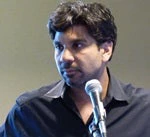 I was in the Indian state of Madhya Pradesh recently. Madhya Pradesh, or MP, as most Indians know it – is a big state in the middle of the country. It also has some of the poorest human development indicators in the country.
I was in the Indian state of Madhya Pradesh recently. Madhya Pradesh, or MP, as most Indians know it – is a big state in the middle of the country. It also has some of the poorest human development indicators in the country.
Some distance from Gwalior, we get off at a large village on the side of the road and start walking away from the highway towards the villages in the interior. Eventually, we cross a stream and reach the last village before a hill stops the road from going any further.
We are in a tribal village, with silos for community grain, a recently constructed Panchayat (the local governing body) hall and a decrepit school. The schools have been closed down after the walls collapsed and snakes were discovered in the classroom. The teachers now hold classes in the temple under a large banyan tree.
Two of the three teachers are there, and they are very nice. The kids sit around the banyan tree and we listen to how the village did receive funds for constructing a new school, but halfway through the money ran out and/or was stolen by the Panchyat members. The third teacher is absent, but most of the times they do show up because of the fingerprinting system. Fingerprinting system? After chatting some more, drinking the obligatory tea and depriving the kids of some of their instructional time, we start walking back.
We reach another village halfway to the main highway. The village is bigger, and a local development scheme is paying for the cement pavements that are being put in. Men sit around on a charpoy in the community hall. We walk to the school that is a bit outside the village. It is decrepit. All the rooms are locked except one, and only one teacher has come today. The kids sit around on a bare floor looking quite despondent and bored. The teacher tells us that he has to come to school every day because of the fingerprinting system. Fingerprinting system? There are no instructional materials that we can see and very few kids. Construction debris lies all around and a few stray dogs roam the school playground. We walk back to the highway.
The third village next to the highway is big, immaculately maintained and has large schools that look great with new paint and vibrant signs announcing the “Sarva Shiksha Abhiyan” or “Education For All” program. School is just ending and the kids all walk out in their uniforms, some singing, others holding hands as they trudge homewards. We meet the head teacher and walk to the tea stall. We ask him how he came to be there. He had been posted to a school in a rural area, in the middle of nowhere, earlier, but then he managed to raise the Rs.30,000 (around $600) to pay the powers that be to get a transfer closer to the main city—Gwalior. He tells us that he had to “personally drop off the cash” at the house of a powerful politician.
We ask him about the fingerprinting system. The chief minister has put in a new system where every government employee who works in the region has to sign in for the day using their fingerprints, or risk having their pay deducted for the day. They also have to sign in by 10am. We go to see this great system. It’s in a room in the panchayat building. There is one computer and a fingerprint recognition system that appears to work fairly well. This would be very cool, were it not for the following:
Problem 1. It takes 5 minutes per employee to get their fingerprints in.
Problem 2. There are many, many government employees.
Therefore - most of them decide not to do the fingerprinting. They call up the higher- ups and complain that it is taking too long.
I thought that the differences between the schools in the three villages were quite interesting given that the distance as the crow-flies from the highway to the interior village was less than 6 km. But the take-away message? It is elusive at best.
I was left with the following thoughts:
- The village in the middle was the most depressing of the lot because most parents sent their children to the bigger village close to the road and therefore were not invested in the school.
- Decentralized funding mechanisms might not actually get spent on their intended purposes - as shown by the interior village, which did not use the school construction funds well.
- Technology alone does not do the trick to ensure that teachers show up to their jobs.
Your feedback:
- I would be interested in exploring whether technology can improve accountability when government oversight is weak. Do you have any success stories where this has been the case?
Photo credit - the image (" Kids sitting down reading, but where is the teacher?") comes from Curt Carnemark), available on the World Bank's Flickr site.


Join the Conversation